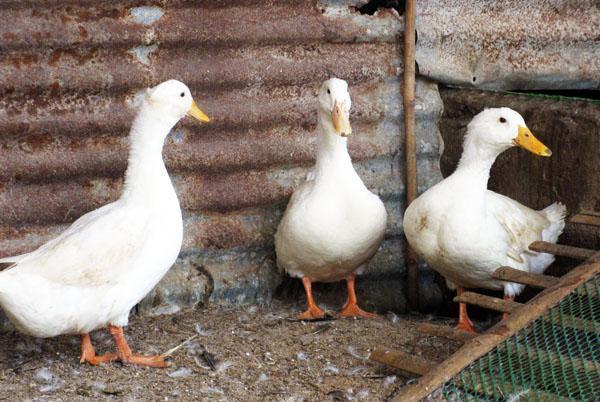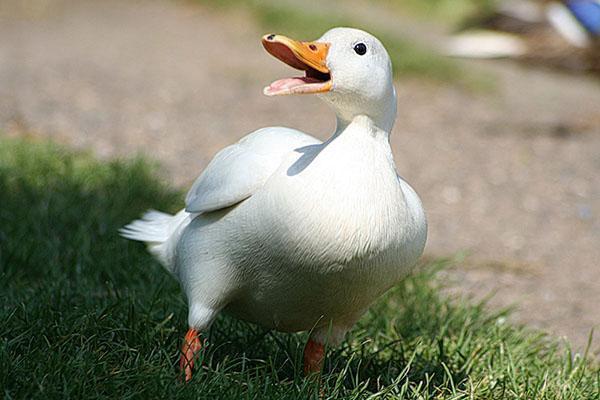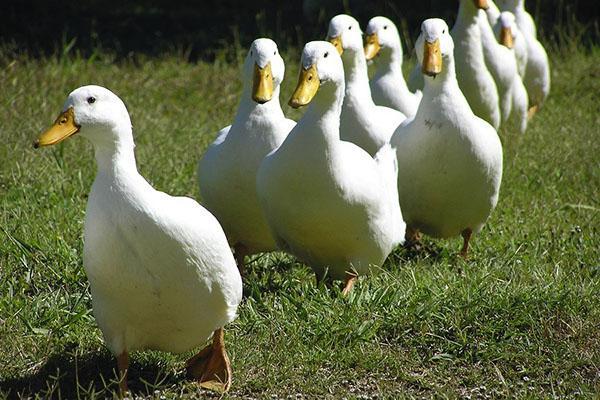Features of the Peking duck breed and the subtleties of its breeding in private farmsteads
 If you conduct a survey of poultry farmers, many will say that the Peking duck must be among the best breeds. Despite the fact that the first information about this breed appeared three centuries ago, and the bird was imported to Europe in the century before last, ducks of Peking origin still compete on a par with the newest meat crosses.
If you conduct a survey of poultry farmers, many will say that the Peking duck must be among the best breeds. Despite the fact that the first information about this breed appeared three centuries ago, and the bird was imported to Europe in the century before last, ducks of Peking origin still compete on a par with the newest meat crosses.
What is the secret of such popularity? How to keep a Peking duck at home, and how profitable is it to breed this breed?
Description of the breed of Peking ducks

These birds are still unsurpassed in terms of speed of weight gain, endurance and unpretentiousness. Peking ducks can be easily kept in any climatic conditions, they are not afraid of cold weather.
Already at a month and a half, ducklings weigh 2.3–3 kg, and a marketable carcass can be obtained in a record four months, when the weight of a duck reaches 4 kg. For a year, the laying hen gives from 80 to 120 eggs weighing about 90 grams. The meat of Peking ducks is tender, juicy, and its yield in relation to slaughter weight reaches 70%.
Features of keeping and breeding Peking ducks
 Intensive feeding allows you to get excellent meat products as early as 60 days after the ducklings are born. However, when breeding Peking ducks at home, slaughter is carried out a little later. Experienced poultry farmers advise not to overexpose the bird. There are several reasons for this.
Intensive feeding allows you to get excellent meat products as early as 60 days after the ducklings are born. However, when breeding Peking ducks at home, slaughter is carried out a little later. Experienced poultry farmers advise not to overexpose the bird. There are several reasons for this.
After 70 days of life, ducks begin to molt, which:
- slows down their growth;
- dramatically increases feed consumption;
- complicates the removal of plumage from carcasses after slaughter.
And with an incorrectly selected diet, such birds can gain not muscle mass, but fat. As a result, the economic benefit of keeping Peking duck is markedly reduced.
Among the features that a poultry farmer needs to know about, who is going to start breeding birds of this productive meat breed, increased nervousness and excitability of ducks. In addition, they are not very good brood hens, so Peking eggs are placed under brood broods of other breeds or in incubators.
For those with experience of content Indo-duck, representatives of the Peking breed seem to be great fans of bathing, but they do not differ in cleanliness.
Breeding ducks at home
 What other features of the content are there? How to care for Peking ducks in a private backyard?
What other features of the content are there? How to care for Peking ducks in a private backyard?
For beginners, breeding Peking ducks at home is associated with the acquisition of daily young animals and the arrangement of the future residence of the livestock. It is better if the chicks are supported and taken care of by the brood hen. This removes a lot of problems from the poultry farmer. If this is not possible, the ducklings are housed in a room where the temperature must be maintained at 28-30 ° C. Heating inside the brooder is maintained with special lamps, heating pads, or other poultry-safe methods. During the first two weeks of life, the house temperature is gradually brought to normal room temperature, and there is no need for additional heating.
 So that fast-growing chicks do not feel cramped, you should not settle more than 15 ducklings per square meter. At the same time, the poultry farmer must constantly monitor the sanitary condition of the premises, the level of humidity, lighting and ventilation, as well as the appearance of the bird. Ducklings showing signs of illness, lethargy, refusing to eat, or disheveled should be removed from the rest of the flock immediately.
So that fast-growing chicks do not feel cramped, you should not settle more than 15 ducklings per square meter. At the same time, the poultry farmer must constantly monitor the sanitary condition of the premises, the level of humidity, lighting and ventilation, as well as the appearance of the bird. Ducklings showing signs of illness, lethargy, refusing to eat, or disheveled should be removed from the rest of the flock immediately.
Attention to feeding Peking ducks should be maximized from the very first hours of life. The first meal awaits the little ones when they are a little dry.
 At this time, the ducklings are fed with moist finely chopped grain mash, porridge, low-fat cottage cheese. The bird is given fermented milk products, a chopped hard-boiled egg.
At this time, the ducklings are fed with moist finely chopped grain mash, porridge, low-fat cottage cheese. The bird is given fermented milk products, a chopped hard-boiled egg.
A few days later, juicy greens are included in the diet of Peking ducks. This could be:
- scalded nettle;
- dandelions;
- clover;
- alfalfa;
- greens of garden peas.
Ducks are very fond of cabbage leaves, carrot tops. To ensure the nutritional value of food, you can add a little boiled crushed potatoes.
And to meet the needs for minerals, ducklings are offered:
- a piece of chalk;
- sifted wood ash;
- crushed shells.
Little by little, the menu includes table salt, seashells and gravel. Up to a week and a half, ducklings are fed six times a day, seasoning the mash with sour milk, fish or meat broth. Gradually, the number of feedings is reduced to four. And from a month old, the bird is released to a safe reservoir, where Peking ducks not only swim with contentment, but also perfectly get food in the form of aquatic vegetation, small crustaceans and insects, mollusks and worms, as well as young local fish.
Despite the naturally high growth rate, Peking ducks, like other related waterfowl, have a fairly short intestine. This speeds up the passage of food and determines a high metabolic rate. In order for the bird to steadily gain weight, it needs to be fed often and satisfyingly.
 Grain feed takes approximately four hours to digest, while wet mixes are processed in just three. In order to obtain good quality meat, it is important to provide a balanced feed rich in both carbohydrates to maintain the body's energy supply and protein for muscle building. Here fish and meat meal is indispensable, and if possible, ducks are given minced fish, chopped and heat-treated meat products.
Grain feed takes approximately four hours to digest, while wet mixes are processed in just three. In order to obtain good quality meat, it is important to provide a balanced feed rich in both carbohydrates to maintain the body's energy supply and protein for muscle building. Here fish and meat meal is indispensable, and if possible, ducks are given minced fish, chopped and heat-treated meat products.
The diet also includes mineral supplements that are responsible for replenishing the body with trace elements, especially calcium, and vitamins.
These include crushed shell and chalk. To improve the digestion of roughage, fine gravel is poured into separate feeders. We must not forget about the need for clean drinking water.
For bathing of birds next to the poultry house, separate containers with water are installed or give the flock access to a reservoir with a safe descent.
Ducks love green succulent plants. Both aquatic vegetation and garden crops are introduced into the summer menu. When breeding Peking ducks at home, you can use boiled potatoes, sugar beets, carrot, other root vegetables. The bird is given soaked bread, yeast rich in B vitamins is added.
 The presence of a nearby reservoir when breeding Peking ducks helps to save a significant amount of feed. However, you cannot completely disclaim responsibility for feeding the poultry farmer. Only if the rules of keeping and caring for the bird are observed, Peking ducks show really outstanding results and give a meat carcass of good fatness and quality.
The presence of a nearby reservoir when breeding Peking ducks helps to save a significant amount of feed. However, you cannot completely disclaim responsibility for feeding the poultry farmer. Only if the rules of keeping and caring for the bird are observed, Peking ducks show really outstanding results and give a meat carcass of good fatness and quality.